The First Galaxy Without Dark Matter Is About To Be Torn Apart

A cosmic puzzle is finally solved, as new observations answer the question of why this galaxy exists at all.
For the last couple of years, astronomy has had a tremendous puzzle to reckon with. When you look at all the large-scale structures out there in the Universe — large galaxies, galaxy groups and clusters, the vast cosmic web and even the all-sky radiation left over from the Big Bang — the same universal picture emerges. In addition to all the normal matter made of Standard Model particles in all their forms, an additional source of invisible mass is required: dark matter. Everywhere we look, on all these large scales, the same 5-to-1 ratio of dark-to-normal matter adequately explains every one of our observations.
But on small scales, the story should be quite different. All the different forces and effects should create two populations of small galaxies: ones with enormous amounts of dark matter relative to their normal matter, which should persist for long periods of time, and ones with very little relative dark matter, which should be destroyed on short cosmic timescales. Yet one galaxy, NGC 1052-DF4 (called DF4 for short), has complicated matters tremendously, as it appears to have no dark matter but hasn’t formed new stars in some 7 billion years. In a brilliant new study led by Mireia Montes, that mystery has at last been solved, as an otherwise common galaxy is in the last stages of being ripped apart. Here’s the science of how we figured it out.
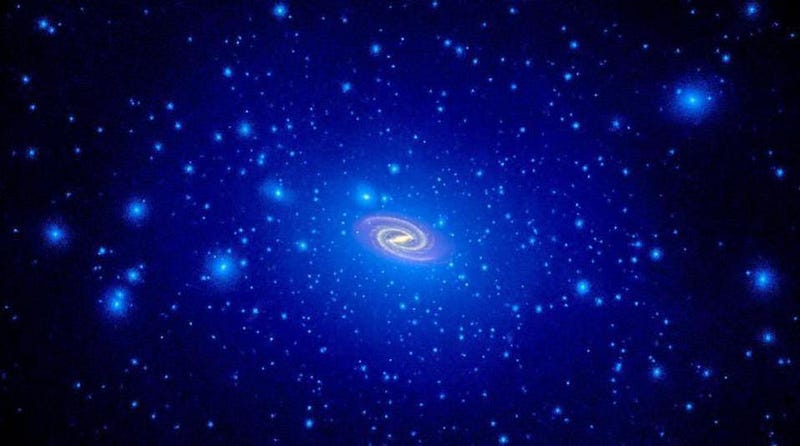
The theory. In theory, dark matter and normal matter both permeate the Universe, but respond differently from one another. If you have a gravitational field, such as a region where the density of matter is greater than the surrounding regions, both normal and dark matter will experience equal attractive forces. But normal matter will:
- collide, clump, and bind together,
- experience inelastic collisions,
- shed both linear momentum and angular momentum,
- and can be pushed around by radiation, such as that produced by new stars,
all while dark matter cannot.
On the largest scales, gravitation is the only force that matters, so these differences don’t play much of a role. But on small scales, and in particular for small, low-mass galaxies, these differences become readily apparent. The most common way this difference appears is in low-mass galaxies (i.e., galaxies that have small escape velocities) form large amounts of stars all at once. When those stars begin shining, producing lots of ultraviolet radiation, the gaseous normal matter can get pushed out and ejected completely, all while the dark matter remains unaffected.
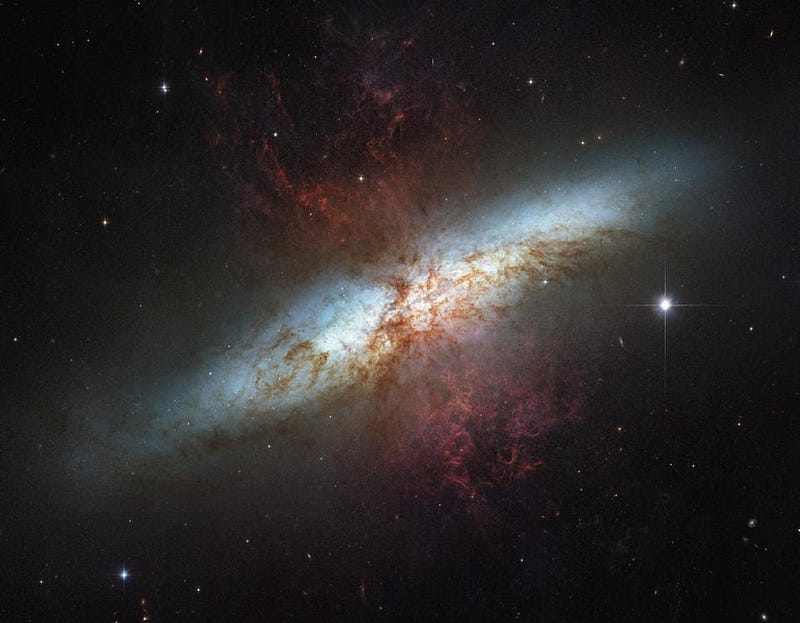
This creates a population of low-mass galaxies with a much greater ratio of dark matter-to-normal matter than the typical 5-to-1 ratio we see on larger scales in the Universe. When we form new stars in the Universe, they come in a wide variety of masses and colors, with the most massive ones producing the greatest amount of winds and high-energy radiation, which can accelerate normal matter (but not dark matter) to high speeds. If a galaxy is too low in mass, that normal matter gets ejected, driving the dark matter-to-normal matter ratio into the hundreds-to-1 or even thousands-to-1 range.
But in theory, a second, rarer population of low-mass galaxies should exist. When gravitational interactions between galaxies occur, they can disrupt the structure of the galaxy. Normal matter and dark matter can both get ripped out in streams due to tidal forces, and while the dark matter will simply wander the Universe, the normal matter can recollapse, forming stars without dark matter. The lack of dark matter, however, makes them easy to destroy through further gravitational interactions, and so they should only live for short amounts of time. In theory.
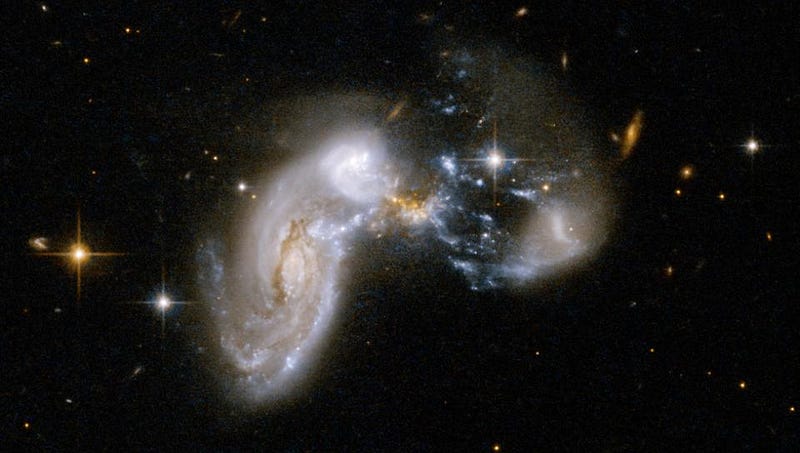
The initial observations. Over the last few years, a new set of instruments have come online, making it possible to measure the intricate properties of larger numbers of low-mass galaxies at greater distances from us than ever before. A few tens of millions of light-years away, a large galaxy called NGC 1052 sits at the center of a modestly large group of galaxies. Many of these galaxies are small, but some of them have interesting shapes as well: the ultra-diffuse dwarf galaxies. They are faint, they consist of older stars, and they have a variety of properties.
Two of them have stood out as objects of interest, however: NGC 1052-DF2 (known as DF2 for short) and the aforementioned DF4. According to previous measurements, both of them are satellite galaxies of NGC 1052, both of them have populations of old stars (where copious amounts of new ones haven’t formed in billions of years), and yet those stars that are present — as well as the globular cluster that are present around them — are moving incredibly slowly. It’s as though these galaxies, somehow, have less gravity holding them together, relative to their size, than any other galaxies at all. Not only can we infer a much lower ratio of dark matter-to-normal matter than in other galaxies, but both galaxies were consistent with having no dark matter at all.
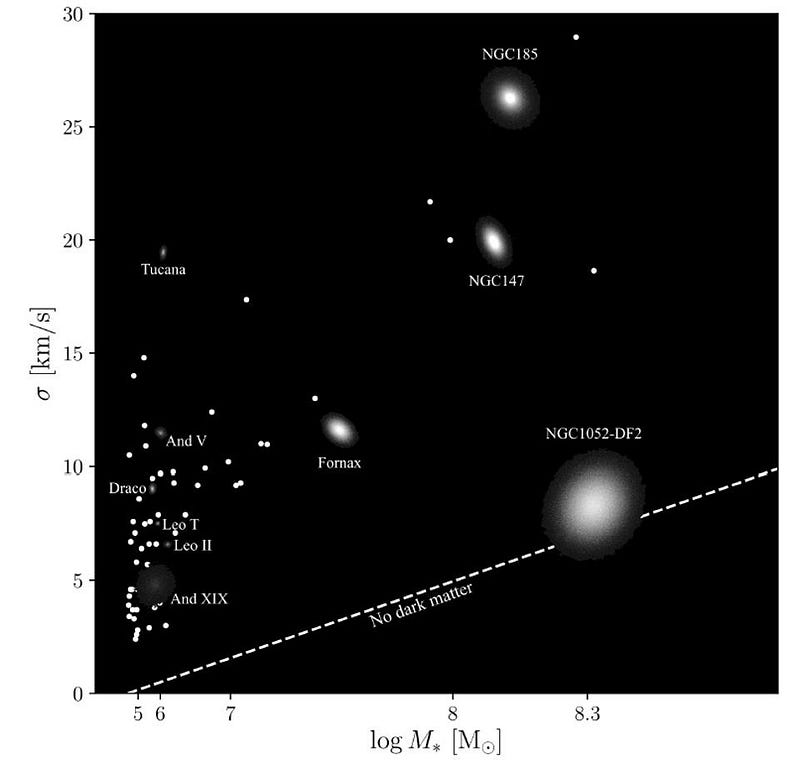
The puzzle. The problem is that these ultra-diffuse dwarf galaxies, DF2 and DF4, are in a rich galaxy group, located in the vicinity of other galaxies. If they really do have very little or no dark matter at all, the gravitational effects of the nearby galaxies should tear them apart. To understand why, imagine a galaxy as a sphere, and imagine a nearby, more massive galaxy as a mass that simply exists at a point somewhat far away. That “point” is going to exert a gravitational force on every part of your spherical galaxy, but different parts of the sphere are going to experience slightly different forces.
We can think about this by thinking about the center of the spherical galaxy as experiencing the average amount of force. Parts that are closer to the external mass are going to experience a greater-than-average force, while parts that are farther will experience a lower-than-average force. Parts that are “north” will experience a slight “southern” force; parts that are “down” will experience a slight “upwards” force, etc. The different parts of the same galaxy will experience a differential force: a tidal force, that works to strip the galaxy of its matter, with the most severe stripping occurring for the outskirts of the galaxy.
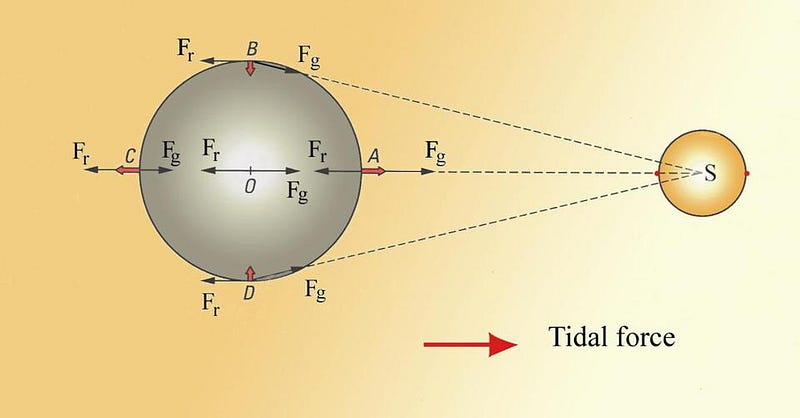
So, if these galaxies are both diffuse (meaning they occupy a large volume) but have no dark matter (meaning they possess very little mass), then tidal stripping should be very easy. It should be so easy, in fact, that galaxies with the properties that DF2 and DF4 are alleged to have should persist for no more than one billion years in environments like the one around NGC 1052. As the galaxies move around, the tugs from other galaxies should tear the stars out of them over time, and without a large, massive halo of dark matter to hang onto them, the entire object should quickly dissociate.
Yet, from the stars inside, we know that not only have these galaxies persisted for many billions of years, but they haven’t formed new stars in something like ~7 billion years! There’s no way, if these galaxies have the properties we observed and then inferred them to have, that they ought to still be around. Something must be amiss, or else something about dark matter and structure formation in the Universe needs to be called into question.
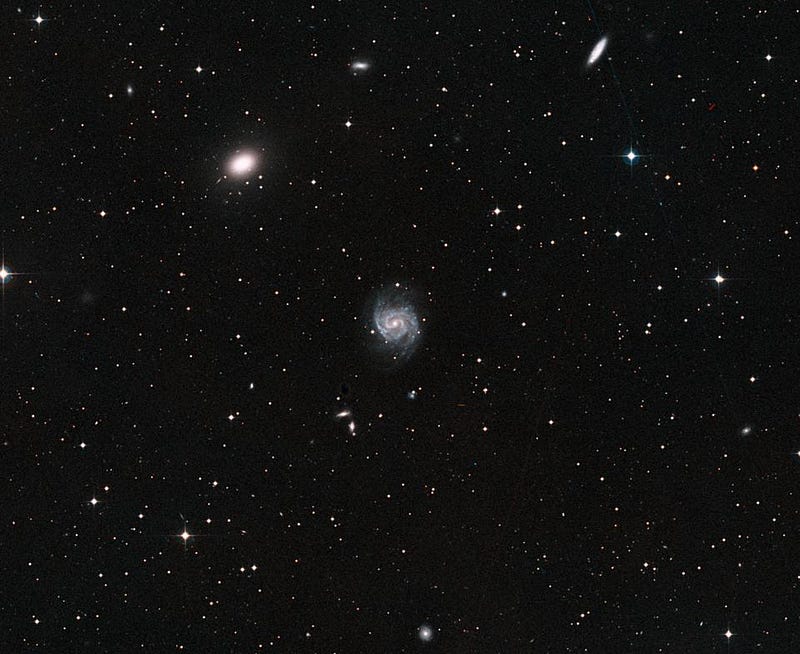
Better observations. Fortunately, one of the burdens-of-proof on an extraordinary claim such as this is to independently confirm and verify that the properties of these objects are what we think they are. When you look at these galaxies, DF2 and DF4, one of the things that could be biasing our measurements is misidentifying which large galaxy (or galaxy group) they’re bound to. Nearby NGC 1052, for example, are two other large galaxies: NGC 1042 and NGC 1035, that are closer to us than NGC 1052 is. Most importantly, they’re along the same line-of-sight, so it’s easy to confuse which galaxy these ultra-diffuse dwarfs are bound to.
If you think a galaxy is farther away than it actually is, you can infer a number of properties incorrectly about it, including:
- its actual, physical size,
- the speed at which objects move around its center,
- and the overall mass required to hold that galaxy together.
Alternative methods of measuring both DF2 and DF4 indicated that they may not be bound to NGC 1052 after all, but might be closer. For DF2, that would indicate that it had a typical amount of dark matter after all, but DF4 still remained a problem. Even adjusting its distance would still result in this puzzle: it has too little dark matter to survive for so long in this environment.
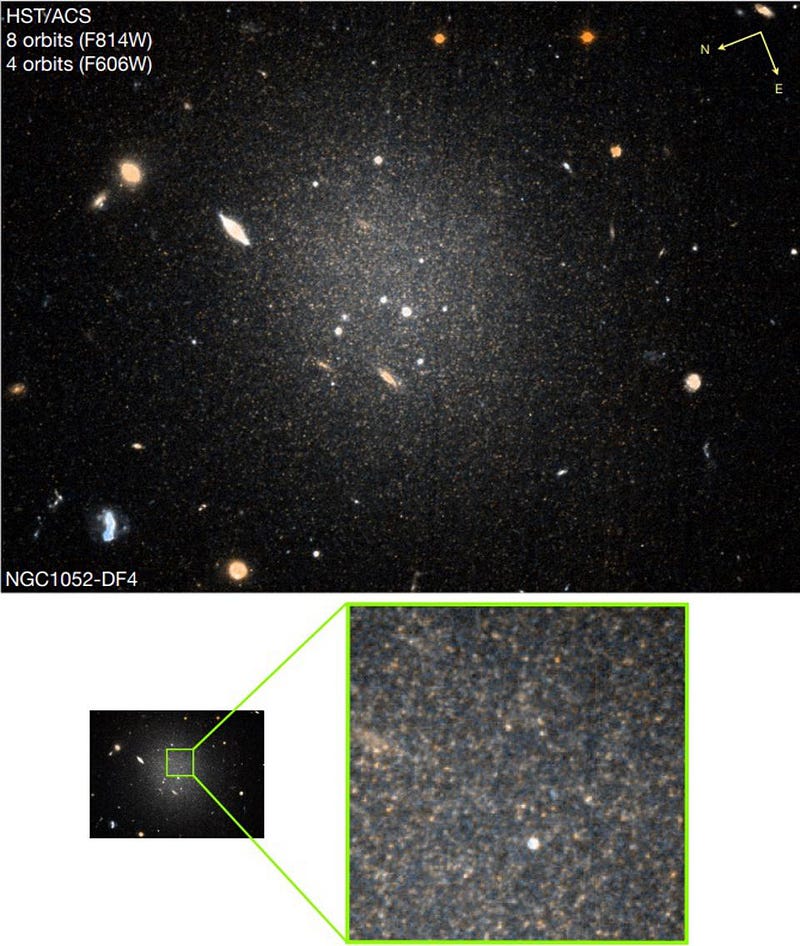
The ultimate explanation. While DF2 is probably bound to NGC 1042, DF4 is very close to the large galaxy NGC 1035. Remember how tidal forces work: more massive objects tear less-massive objects apart by exerting different forces on different parts of the object. If DF4 is close to a large galaxy, it’s going to be stretched along one dimension (towards the large galaxy) and compressed in the other, perpendicular dimensions.
In addition, the matter that gets stripped out of this galaxy should do so from the outside-in. The material on the galactic outskirts should be stretched first and most severely, making it the easiest to remove. The material that begins at the center of the object should survive the longest, remaining unperturbed until the very end. And remember: even in these small, ultra-diffuse dwarf galaxies, there should still be a halo of dark matter around them that is much larger and more diffuse than the normal matter. Whereas normal matter sticks together and sinks to the center, dark matter remains predominantly in the outskirts.
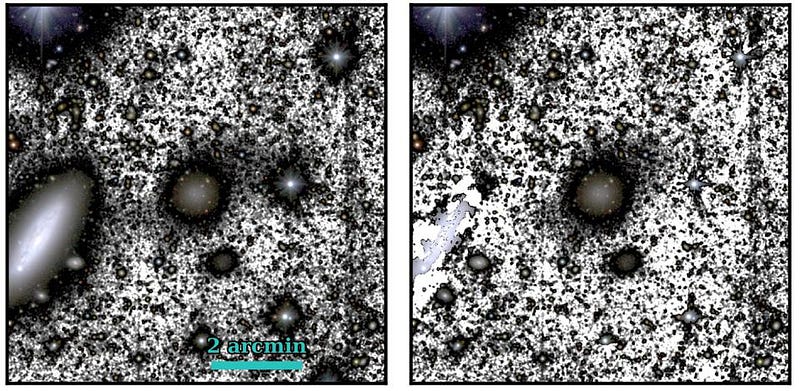
And that’s where the key is, according to Montes’s team. If DF4 was a typical ultra-diffuse dwarf galaxy — that last formed stars 7 billion years ago, that has practically no gas left, but did have a large dark matter halo — then we could ask, “what would happen if it found itself nearby a large, massive galaxy?” The answer is as follows:
- the dark matter slowly begins to get stripped away from the galactic outskirts,
- reducing the “depth” of the gravitational potential well that holds the galaxy together,
- with the stripping intensifying as the galaxy gets closer to the more massive neighbor,
- where the central stars, made of normal matter, will be the last thing to get stretched, stripped, and torn apart.
If this were what’s going on, you’d have to remove about ~90% of the dark matter before the stars began to get tidally disrupted. And thanks to brand new Hubble observations, a part of the recent paper (free version available here), we can clearly see that the stars are finally starting to be affected.
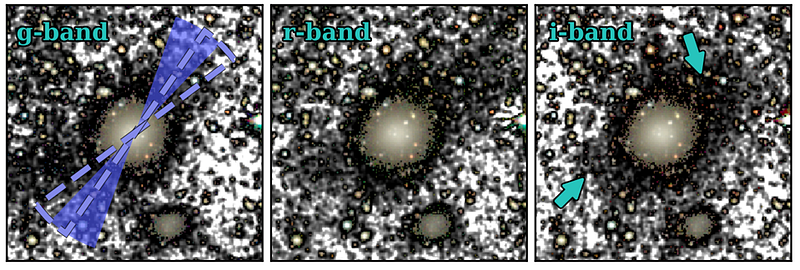
Although it’s only affecting roughly 7% of the stellar mass right now, this tidal interaction with a large, massive neighbor is sufficient to solve this dark matter puzzle. The reason its stars are so old is because it was created long ago; the reason it has practically no dark matter is because the dark matter is being actively stripped out of it right now; the reason it still survives today is because it’s undergoing active disruption, and will likely be destroyed in short order, at least on cosmic timescales.
The whole point is this: you can’t have a long-lived galaxy without dark matter. You can lose your dark matter through a tidal interaction, which creates a stellar aggregation known as a tidal dwarf galaxy, but these are transient: short-lived, and easy to tear apart. The mystery of DF4 is that it looks like an ultra-diffuse galaxy, not a tidally disrupted galaxy, because it was an ultra-diffuse galaxy up until very recently. The tidal disruption affected the dark matter first, and only now — now that it’s almost entirely gone — are the stars starting to be disrupted, too. With this new discovery, the puzzle may be completely solved, teaching us why DF4 has no dark matter, after all.
Starts With A Bang is written by Ethan Siegel, Ph.D., author of Beyond The Galaxy, and Treknology: The Science of Star Trek from Tricorders to Warp Drive.





